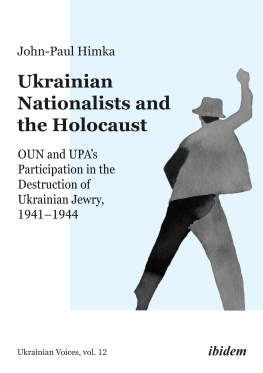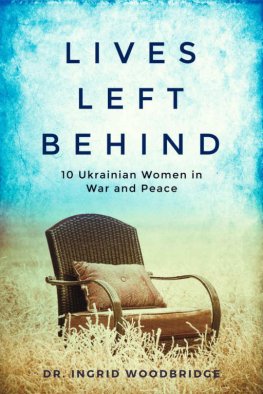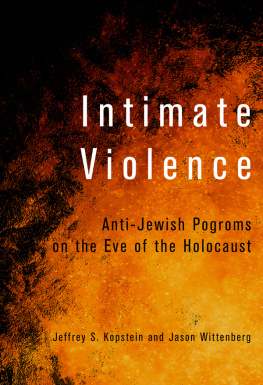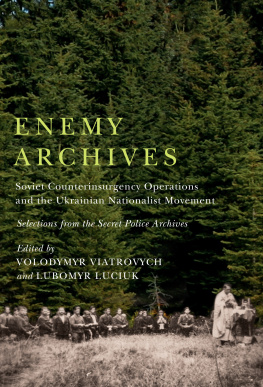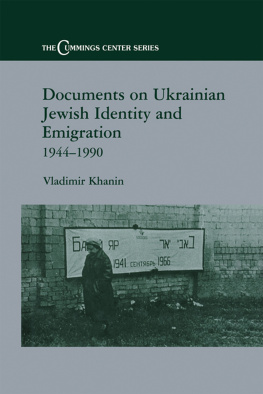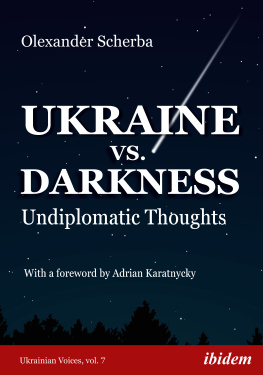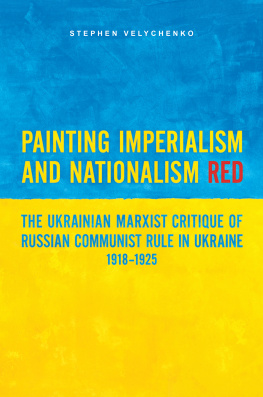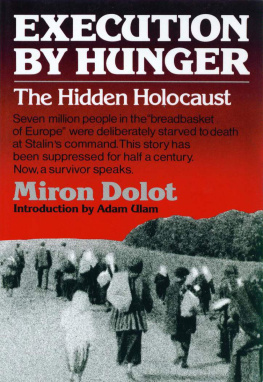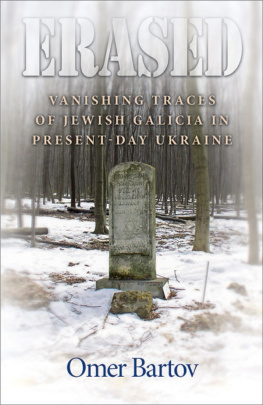ibidem -Press, Stuttgart
For Chrystia
who stood beside me
Contents
Acknowledgments
I have received support for the research that went into this book from the Social Sciences and Humanities Research Council of Canada; Pinchas and Mark Wisen Fellowship at the Center for Advanced Holocaust Studies, United States Holocaust Memorial Museum; Killam Fund, University of Alberta; Support for the Advancement of Scholarship, Faculty of Arts, University of Alberta. I am very grateful for their generosity.
It has been a pleasure working with ibidem-Verlag, particularly with Jana Dvers, Valerie Lange, and Andreas Umland. I appreciate their guidance and respect for an authors vision of a book.
I have many people to thank. Although I am responsible for all the views put forward in this volume, I have had a great deal of help along the way. Persons who need to be singled out for their contribution to the appearance of this study are Vadim Altskan, Tarik Cyril Amar, Omer Bartov, Andriy Bolianovsky, Jeffrey Burds, Marco Carynnyk, Martin Dean, Sofia Dyak, Ernest Gyidel, Wendy Lower, Jared McBride, Oleksandr Melnyk, Ada Ogonowska, Dieter Pohl, Antony Polonsky, David Lee Preston, Per Anders Rudling, Roman Solchanyk, Wiesaw Tokarczuk, and Larry Warwaruk. The following scholars worked at one point or another as research assistants for this book: Eduard Baidaus, Natalka Cmoc, Eva Himka, Rylan Kafara, Taras Kurylo, Mariya Melentyeva, Michal Mlynarz, Oksana Mykhed, Iaroslav Pankovskyi, and Grzegorz Rossoliski-Liebe. Those who read and helped me rework chapters were Raisa Ostapenko, Alan Rutkowski, the East Europeanist Circle at the University of Alberta led by Heather Coleman, and participants in the Danyliw Seminar in 2018. I wish I had the words I need to express the depth of my gratitude.
Abbreviations
AIHArchiwum ydowskiego Instytutu Historycznego
BA-MABundesarchiv/Militrarchiv, Freiburg
CPSUCommunist Party of the Soviet Union
DALODerzhavnyi arkhiv Lvivskoi oblasti
DAIFODerzhavnyi arkhiv Ivano-Frankivskoi oblasti
DARODerzhavnyi arkhiv Rivnenskoi oblasti
DAZhODerzhavnyi arkhiv Zhytomyrskoi oblasti
EMEreignismeldungen UdSSR des Chefs der Sicherheits-polizei und SD (title varies)
f.folio
HDA SBUHaluzevyi derzhavnyi arkhiv Sluzhby bezpeky Ukrainy
KGBKomitet gosudarstvennoi bezopasnosti
KPZUKomunistychna partiia Zakhidnoi Ukrainy
NANUNatsionalna Akademia nauk Ukrainy
NKGBNarodnyi komissariat gosudarstvennoi bezopasnosti
NKVDNarodnyi komissariat vnutrennikh del
NTShNaukove tovarystvo im. Shevchenka
op.opys
OUNOrganization of Ukrainian Nationalists
OUN-BOrganization of Ukrainian Nationalists (Bandera faction)
OUN-MOrganization of Ukrainian Nationalists (Melnyk faction)
P Polish
PUNProvid ukrainskykh natsionalistiv
r.g.record group
Ro Romanian
RSHAReichssicherheitshauptamt
SB OUNSluzhba Bezpeky Orhanizatsii ukrainskykh natsionalistiv
SBUSluzhba Bezpeky Ukrainy
SDSicherheitsdienst
spr.sprava
TsDAHOTsentralnyi derzhavnyi arkhiv hromadskykh ob iednan Ukrainy
TsDAVOTsentralnyi derzhavnyi arkhiv vyshchykh orhaniv vlady ta upravlinnia Ukrainy
TsDIALTsentralnyi derzhavnyi istorychnyi arkhiv Ukrainy, m. Lviv
TsGAORTsentralnyi gosudarstvennyi arkhiv Oktiabrskoi revoliutsii, vysshikh organov gosudarstvennoi vlasti i organov gosudarstvennogo upravleniia SSSR
UCRDCUkrainian Canadian Research and Documentation Centre
UHVRUkrainska holovna vyzvolna rada (Ukrainian Supreme Liberation Council)
UNDOUkrainske natsionalne demokratychne obiednannia (Ukrainian National Democratic Union)
UPAUkrainska povstanska armiia (Ukrainian Insurgent Army)
USHMMUnited States Holocaust Memorial Museum
UVOUkrainska viiskova orhanizatsiia (Ukrainian Military Organization)
Vverso
YIUNYahad-in Unum Testimony
YVAYad Vashem Archives
Introduction
The Theme and Plan of the Book
This study concerns the participation of the Organization of Ukrainian Nationalists (OUN) and its armed force, the Ukrainian Insurgent Army (Ukrainska povstanska armiia, UPA), in the destruction of the Jewish population in Ukraine under German occupation, 1941-44. There were three major phases in which the nationalists contributed to the mass murder. (Since I do not use the definite article before OUN and UPA, readers would be advised to pronounce these terms as acronyms: o-OON, oo-PA.)
First, militias organized by OUN were key actors in the anti-Jewish violence of the summer of 1941, in the immediate aftermath of the German invasion of the Soviet Union. The militias arrested Jews in order to subject them to forced labor, humiliation, and murder; thousands of those arrested were executed by German units, mainly Einsatzgruppe C and Waffen-SS Division Wiking. The Ukrainian nationalist militias assembled the Jews for the Germans violence, since they could identify Jews more easily than the invaders and knew the localities, including Jewish neighborhoods in the cities. Sometimes the violence was accompanied by bloody public spectacles, as in the pogroms unleashed in Lviv and Zolochiv in early July 1941; sometimes the OUN militias murdered selected Jews and their families more discreetly, and sometimes they just murdered all the Jews in a village.
Second, OUN recruited for and infiltrated the Ukrainian Auxiliary Police in Galicia and the stationary Schutzmannschaften in Volhynia. These police units provided the indispensable manpower for the Holocaust. They rounded up Jews for deportation to the death camp at Beec or for execution by shooting; although most of the actual killing was done by the Germans, the Ukrainian policemen also killed in certain circumstances. These liquidation actions took place primarily from early 1942 through the middle of 1943.
Third, early in 1943 thousands of these Ukrainian policemen deserted from German service to join the OUN-led nationalist insurgency. Possessed of some military training and familiarity with both weapons and killing, they took leadership positions in UPA. As soon as the former policemen joined them, UPA launched a massive ethnic cleansing project, at first in Volhynia and later in Galicia. Although it was primarily directed against Poles, there were other non-Ukrainian victims, including Jews. In the winter of 1943-44, as the Red Army moved westward, UPA lured surviving Jews out of their hiding places in the forests, temporarily placed them in labor camps, and then murdered them.
In each of these three phases of anti-Jewish violence, the responsibility of OUN was different. In the first phase, the militias, and the OUN leadership which established them, were primarily responsible for rounding up Jews for the Germans, although the militias did some killing themselves. Altogether the militias were accomplices in the murder of thousands of Jews and shooters in the murder of many hundreds. In the second phase, OUN cannot be held responsible for all that Ukrainian policemen did in Galicia and Volhynia, since police structures were primarily under German control and by no means were all the policemen nationalists, at least initially. OUN's responsibility here lay in its strategy of deliberately infiltrating the police, which drew its members and sympathizers into the eye of the genocidal storm. For the most part, Ukrainian policemen rounded Jews up for others to kill, but sometimes they themselves killed Jews. Altogether the death toll from police roundups was in the hundreds of thousands. In the third phase, OUN's responsibility was direct. Here, the organization was killing Jews primarily on its own initiative, as part of a far-reaching ethnic cleansing project; it was not only finding the Jews for murder, but its forces were perpetrating the killings themselves. The Jewish victims of OUN in this phase probably numbered in the thousands.

